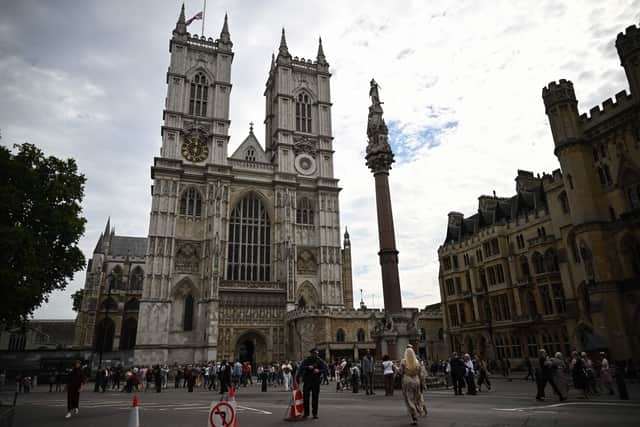Where is Westminster Abbey? Coronation location for King Charles III explained - when was it built
and live on Freeview channel 276
Westminster Abbey has been Britain's coronation church since 1066 and on Saturday 6 May, King Charles III will become the 40th reigning monarch to be crowned.
Thousands of world leaders and dignitaries arrived at Westminster Abbey last year for the Queen’s state funeral on 19 September. Her Majesty’s state funeral followed the lying-in-state at Westminster Hall, which lasted for four days, with the Queen’s coffin then making the journey to Westminster Abbey.
Advertisement
Hide AdAdvertisement
Hide AdSo where is Westminster Abbey and what is its significance? Here’s everything you need to know.


Where is Westminster Abbey?
Westminster Abbey is located in central London, just west of the Houses of Parliament, in the Greater London borough of Westminster.
The closest tube station to the Abbey is Westminster on the Jubilee, District & Circle Lines and St. James’s Park on the District and Circle Line.
The nearest rail station is either London Victoria or London Waterloo.
When was it built?
Advertisement
Hide AdAdvertisement
Hide AdWestminster Abbey was built in 1269 AD, making it over 800 years old. The Abbey is set on the grounds of a former Benedictine monastery which was built in 960 AD.
In 1040, King Edward decided to enlarge the monastery, adding on a church, which became known as the “West Minster”, whilst St Paul’s was known as the “East Minster”. The King did not survive to see the church’s consecration and was entombed in the high altar following his death.
The Abbey has undergone many changes throughout the last eight centuries, with King Henry III deciding to redesign it in the 13th Century. Another new addition was added on by King Henry VII, the first of the Tudors, he commissioned the Lady Chapel, which is known for its fan-vaulted roof.
The western towers, which had been left unfinished since the Middle Ages, were finally completed in 1745.
Advertisement
Hide AdAdvertisement
Hide AdKings and Queens have been crowned at the Abbey since 1066, with the Abbey being the burial place for more than 3,000 royals and people of historic significance.
In 1987, it was designated a UNESCO World Heritage site.
Which Kings are buried there?
Westminster Abbey is the final resting place for over 3,000 people, including 30 Kings and Queens. The first King to be buried in the abbey was King Edward the Confessor who died before its completion.
His ornate tomb stands behind the high altar.
Here are the Kings who are buried in Westminster Abbey:
- Henry III
- Edward I
- Edward III
- Richard II
- Henry V
- Edward V
- Henry VII
- Edward VI
- James I
- Charles II
- William III
- George II
The last King to be buried in Westminster Abbey was King George II who died in 1760. He was buried in a vault under the central chapel aisle, with his queen Caroline.
As well as monarchs, people of historical significance are also buried in the Abbey including William Pitt, Geoffrey Chauncer, Henry Purcell, Charles Darwin and Issac Newton.
Advertisement
Hide AdAdvertisement
Hide AdMost recently, in 2018, the ashes of prominent physicist Stephen Hawking were interned in the Abbey.
When was the Queen’s funeral?
The Queen’s funeral was held at Westminster Abbey on Monday 19 September at 11am.
Her Majesty had celebrated many important events at the Abbey, including her wedding to Prince Philip in 1947 and her coronation in 1953. It was also the scene of royal weddings, including that of Prince William, the Prince of Wales and Catherine the Princess of Wales in 2011.
However, it also had sad memories for the Queen, with the ceremonial funeral of late husband, Prince Philip being held there in 2021. The Queen herself had a state funeral at the Abbey, led by the Archbishop of Canterbury Justin Welby.
Comment Guidelines
National World encourages reader discussion on our stories. User feedback, insights and back-and-forth exchanges add a rich layer of context to reporting. Please review our Community Guidelines before commenting.
